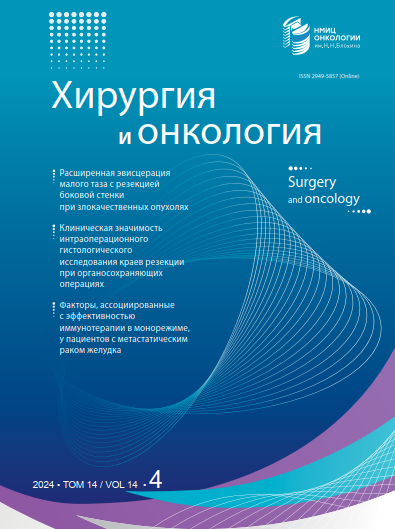Mapping during morphological study of samples of laterally spreading colon neoplasia after endoscopic submucosal dissection
- Authors: Setdikova G.R.1,2, Verbovsky A.N.1, Semenkov A.V.1,3
-
Affiliations:
- Moscow Regional Research and Clinical Institute
- State University of Education
- I.M. Sechenov First Moscow State Medical University, Ministry of Health of Russia
- Issue: Vol 14, No 4 (2024)
- Pages: 11-19
- Section: DESCRIPTION OF THE METHODOLOGY
- Published: 29.11.2024
- URL: https://onco-surgery.info/jour/article/view/752
- DOI: https://doi.org/10.17650/2949-5857-2024-14-4-11-19
- ID: 752
Cite item
Full Text
Abstract
Introduction. According to the literature, the detection rate of laterally spreading tumors has increased in recent years due to the constant development of endoscopic diagnosis and treatment technologies. It is reported that these neoplasms account for about 15 % of all colorectal neoplasias. According to the literature, laterally spreading tumors are characterized by a more frequent presence of areas of malignancy compared to polypoid formations. Since such neoplasms are closely correlated with colorectal cancer, it is very important to fully understand the clinical presentation and morphological characteristics to select the optimal treatment strategy.
Aim. The development of mapping of samples during morphological examination with subsequent correlation with endoscopic data and search for the most suitable areas for taking a biopsy.
Materials and methods. To solve the problem described above, a mapping technology was developed for the morphological study of samples of laterally spreading colon neoplasia, which consists in creating an algorithm of actions, described in more detail in the work.
Results. The first step of gross is the correct orientation of the resected specimen. The macroscopic integrity of the removed specimen is described. When describing microscopic data, the first question that the morphologist must answer is whether the process is benign or malignant. In case of malignant processes, the morphologist must answer according to the questionnaire: histological type, degree of differentiation / dysplasia, size (mm), depth of invasion, assessment of resection margins, lymphovascular and perineural invasion, tumor kidneys.
Conclusion. The presented technique, when used in everyday pathological practice for neoplastic neoplasms of the colon, can allow a reliable assessment of all prognostic factors and the development of an objective interdisciplinary consensus for further treatment.
About the authors
G. R. Setdikova
Moscow Regional Research and Clinical Institute;State University of Education
Author for correspondence.
Email: galiya84@mail.ru
ORCID iD: 0000-0002-5262-4953
Galiya R. Setdikova
Department of Fundamental Medical Disciplines, Faculty of Medicine, State University of Education
61/12 Shchepkin St., Moscow 129110,
Bld 2, 10 A Radio St., Moscow 105005
Russian FederationA. N. Verbovsky
Moscow Regional Research and Clinical Institute
Email: fake@neicon.ru
ORCID iD: 0000-0002-0831-0973
61/12 Shchepkin St., Moscow 129110
Russian FederationA. V. Semenkov
Moscow Regional Research and Clinical Institute;I.M. Sechenov First Moscow State Medical University, Ministry of Health of Russia
Email: fake@neicon.ru
ORCID iD: 0000-0002-7365-6081
Department of Oncology, Radiotherapy and Reconstructive Surgery, I.M. Sechenov First Moscow State Medical University, Ministry of Health of Russia
61/12 Shchepkin St., Moscow 129110,
Bld. 1, 6 Pirogovskaya St., Moscow 119992
Russian FederationReferences
Supplementary files






